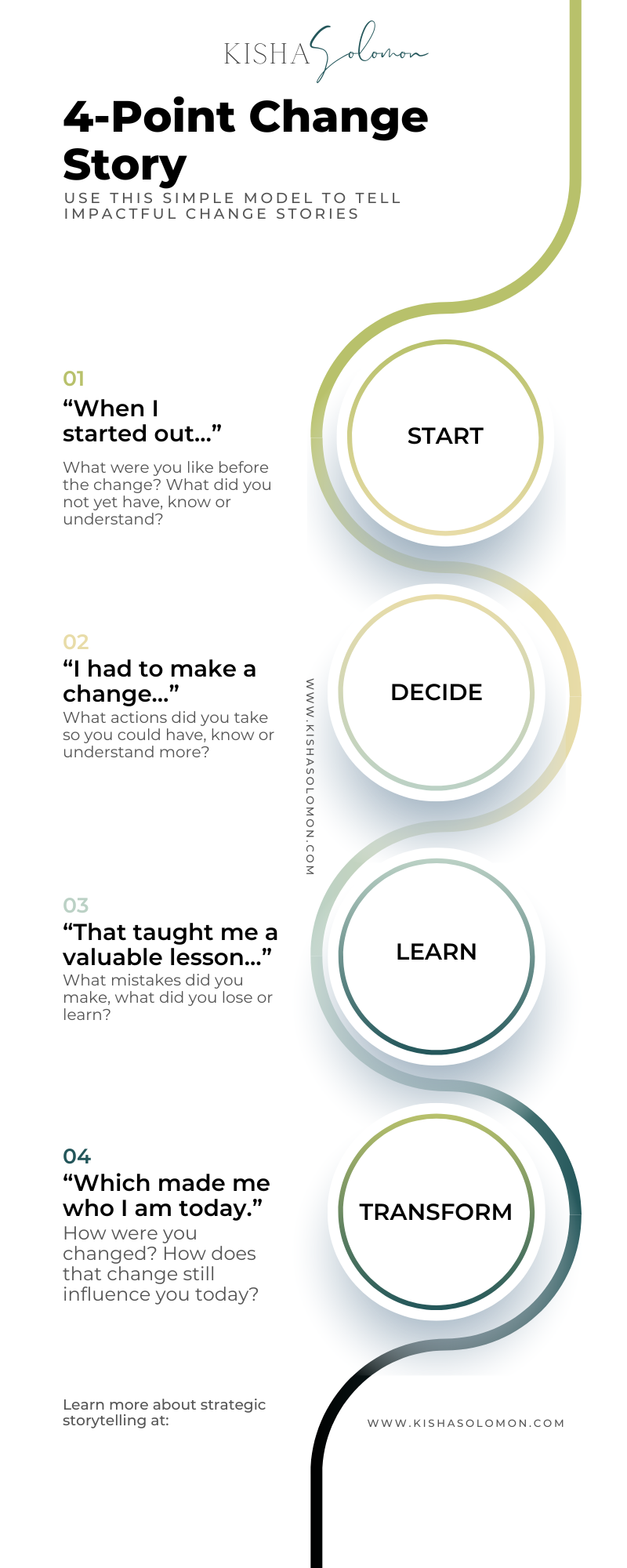The 5 Storytelling Moments That Shape Team Culture
Every team experiences key moments where the stories being told can either unite or divide, motivate or disengage. Here are five critical storytelling moments that occur on a team and how they impact team culture and employee experience.
1. Initiation / Onboarding
This is the moment when a new team is formed or a new team member joins. It sets the foundation for collaboration, trust, and alignment. The stories shared during onboarding shape perceptions of the team’s mission, leadership, and ways of working.
2. Planning
This moment involves setting goals, defining roadmaps, and aligning on deliverables. It’s when teams determine what success looks like and how they’ll get there.
3. Progress & Performance Reviews
Teams regularly check in on progress through sprint reviews, stand-ups, or stakeholder updates. These moments determine whether the team feels acknowledged and supported or micromanaged and undervalued.
4. Conflict in Objectives or Priorities
Disagreements over goals, resourcing, or timelines are inevitable. How these conflicts are navigated and communicated determines whether they become a turning point for innovation or a catalyst for team dysfunction.
5. Closeout / Offboarding
This is the moment when a project wraps up or a team member transitions out. The stories shared at this stage define the legacy of the work and the team’s sense of accomplishment or failure.
Final Thoughts
Every team experiences these five storytelling moments. The question is: Are you shaping them intentionally or letting them unfold haphazardly? By paying attention to these moments and crafting positive narratives, you can transform team culture, improve engagement, and build a more resilient and motivated team.
how to lose like a winner
3 questions to ask yourself after you’ve experienced a loss or a failure.
A couple of weekends ago, I got invited to watch a friend’s daughter compete in the National American Miss pageant. I’ve known this young lady since she was a toddler, and over the years I’ve watched her blossom into an awesome little woman. She’s bright, energetic, savvy, and beautiful to boot. You know, one of those kids that makes you feel confident about what the next generation will be able to do with their infinite potential. So I was thrilled to join her parents in the audience to hoot and holler like a madwoman whenever she appeared on the stage.
That night, we watched all the contestants do their opening numbers and have their individual moments in the spotlight. We also watched watch as girl after girl got picked for various and sundry titles – Miss Congeniality, Most Likely to be a Top Model, Most Likely to End Up as a Trophy Wife and Get One Helluva Divorce Settlement when the Dog of a Husband Gets Caught Cheating (or something like that).
Even with all her charm, poise, and intelligence, our girl didn’t get a single trophy or accolade, and she didn’t even get to move on to the next round of competition. Needless to say, we were crushed. She, of course, was even more crushed. After she’d changed back into her street clothes, she joined us to head to the car. She held up pretty well for a few moments, then the tears came. “It isn’t fair,” she cried. “They weren’t as good as me!” she protested. And we agreed, clucking over her and consoling her like dutiful supporters. There wasn’t any use in trying to rationalize the outcome of the pageant to her. Even if there had been a rational explanation, it likely wouldn’t have made a dent on her emotional state. So, I thought that the words her mother offered her were the best that could be said at that moment. She simply told her daughter, “Baby, it wasn’t your time.”
No doubt, losing sucks. Hard. Especially when it’s something you’ve worked hard to get, or something you feel like you’re naturally more qualified to have. So when you don’t land that job, or you get passed over by that girl or guy you had your heart set on, or someone else snags that grand opportunity that you know was meant for you, it makes you want to scream at the top of your lungs, “It’s not fair! They weren’t as good as me!” It’s irritating as hell to see the lesser-qualified get your moment in the spotlight, with the crowd cheering and the fair maiden planting a wreath of laurel leaves on their unworthy head. When it happens more than once, you may stop screaming outwardly and start whispering inwardly to yourself: “Maybe I’m not good enough. Maybe I don’t know what I’m doing. Maybe no one will ever want me.” Even the most confident and self-assured person has their moments of uncertainty when met with a consistent stream of losses.
I thought back to one of the girls in the pageant who had advanced to the next round that evening. It was her fifth year in the competition, and she’d never made it beyond the first round before. Yet she kept showing up every year. Kept donning the glitzy gown, kept flashing the perfect camera-ready smile, and kept being sent home with nothing to show for her efforts. I wondered what she must have felt like after two years of not winning. After year three? I wondered how she even mustered up the energy and optimism it took to come back for one more chance at winning, though she was a repeat loser. By the colloquial definition, this girl was insane. She kept doing the same thing and expecting a different result. But eventually, after five long years, she did get a different result.
So how exactly do you distinguish the insane person from the winner-to-be?
"Sometimes losing is a wake-up call in disguise, a universal conspiracy that’s letting you know that you’re chasing the wrong dream..."
Winners recognize that there may not be any logic to the fact that they lost, but they take the loss as an opportunity for assessment. A time to prepare themselves for the win that will inevitably come. After a loss, winners ask themselves the following questions:
AM I LOSING BECAUSE I’M PLAYING THE WRONG GAME?
If you’re going after something that doesn’t align with your purpose or your true values, why would you want to win? Sometimes losing is a wake-up call in disguise, a universal conspiracy that’s letting you know that you’re chasing the wrong dream, and you need to set your eyes on a different, more fitting prize. If you feel certain that what you’re after does align with your purpose, it’s much easier to deal with temporary losses on the way to your goal.
AM I LOSING BECAUSE I'M NOT YET PREPARED TO WIN?
and the winner is
If you were to get that job, land that cutie pie, or be granted that opportunity, are you currently prepared to make the most of it? Do you have the skills to maintain the thing you’ve won after you’ve won it? You’ve heard the stories of lottery winners who are penniless only a few years after their big win, because they had no money management skills. It’s almost impossible to believe, but it happens all the time – and not just with the lottery. Winners take time after a loss to continue to hone their skills. They visualize what they’ll need to do after the win to make sure they’re ready to perform when it happens. Winners know that a gift given to the ill-prepared can easily become a curse.
AM I LOSING BECAUSE IT JUST ISN’T MY TIME?
So you know for sure that you’re after the right thing. And you know that you’re well-prepared to maintain that thing after you’ve won it. So what gives? Why do you keep losing? Well baby, maybe it just isn’t your time. While you’re fuming about how unfair it all is, maybe there’s someone else out there who had just as much right to the ‘big win’ as you did. They may have waited longer or worked harder, or maybe it was simply ‘their time’. Maybe you’re like that year-five winner, and you’ll have to lose many times before you win. Just remember to re-assess, re-equip, and reapply yourself… even if everyone else thinks you’re insane.
As it turns out, our girl made it through the pageant ordeal without too much emotional or ego damage. After a post-pageant dinner out, she was mostly back to normal. The following week, she got an unexpected phone call. It came from a talent scout who’d seen her at the pageant and wanted to know if she was available for other opportunities.
So let that be a lesson to all you losers out there. The next time you lose, go ahead and have a good cry, check to make sure the makeup is still ok, then treat yourself to something tasty.
And know this… your day is coming. Maybe even sooner than you think.
cheers,
k
are you ready for solo travel? 6 questions to ask
Don’t even think about going on your first solo trip without asking yourself these 6 questions.
People’s opinions about travelling solo usually fall into one of two camps. It’s either one of the boldest, most exciting ideas they’ve ever heard:
It’s so empowering!
It takes guts!
Why wait on someone else, when you can just go?
Or, it’s something that they’d never consider doing:
It’s dangerous!
I’d be bored!
What if the kidnappers come, and Liam Neeson doesn’t come save me?
I’ve been travelling solo for years now. Not necessarily because I love it or even prefer it, but mainly because my desire to travel exceeds my ability to wait for someone else to be able and ready to join me. I also know that my travel style isn’t exactly everyone’s cup of tea – so to avoid conflict, I often opt for the solo adventure.
Does that make me a solo travel expert? Hardly. But I often see many women asking of other solo women travelers how we got the nerve/confidence/lady cojones to travel all by ourselves, so I thought I’d wrangle up some questions worth asking yourself if you think you might be ready for solo travel.
find out if you're ready for solo travel
#1 - HOW EASILY DO YOU MAKE NEW FRIENDS?
Can you find something you have in common with almost anyone? Are you the one at a party who flits among various groups and dips in and out of multiple conversations with ease? Those extrovert social skills will definitely come in handy when you’re travelling on your own.
If you’re more of the introverted, wallflower type, you might still consider travelling alone… in a group. Group tours, cooking classes and local meetup groups can make it easier for shyer types to not feel so lonely when travelling alone. Cruises are also a great option for some solo travelers who like being on their own, but still want to be surrounded by somewhat familiar people.
#2 - HOW DO YOU REACT TO UNFAMILIAR OR AMBIGUOUS SITUATIONS?
Are you ok with having to find your way in a new place? Getting lost? Not knowing what other people around you are saying? Having to use rudimentary sign language to get your point across? International solo travel is right up your alley! If you’re ok with everything not being exactly the way it is back home (this could include anything from acceptable clothing to toilet facilities), then you’ll be just fine on your own in foreign locales.
If the very thought of the situations described above is enough to make you break out in hives, then maybe you should start out by travelling solo somewhere closer to home – somewhere with more familiar food, language, sights and sounds. Stay in a hotel chain that you’ve stayed in before; book a room at a bed-and-breakfast in a neighboring state; visit a well-documented, much-visited historical site and enjoy your trip without feeling like a fish out of water. If you're still determined to go abroad, try a country where language or unfamiliar customs won't be a barrier.
#3 - HOW STRONG / ACCURATE IS YOUR ‘LITTLE VOICE’?
I’ve said it many times – my best travel tool is my intuition, aka, ‘the little voice’. The little voice tends to grow stronger and more accurate with experience, so if you’ve already travelled extensively with others or have lived in a major city where you may regularly encounter potentially shady characters or situations, your little voice is likely well-tuned.
On the other hand, if people who know you well refer to you as ‘too trusting’, or ‘naïve’ (and you know they’re telling the truth), or conversely, if you think EVERYone is a potential murderer/terrorist/rapist, then maybe you should enhance your intuition a bit before striking out on your own.
#4 - HOW CURIOUS ARE YOU?
My biggest motivation for non-work-related travel is curiosity. What’s happening elsewhere? What do people eat there? How do they spend their free time? Are the mens cute? If you’re the curious and exploring type who can only be satisfied by seeing and experiencing something for yourself, that curiosity will not only be a catalyst for you to book your solo trip, it will also make what happens on your trip more memorable and satisfying.
#5 - HOW MUCH DO YOU ENJOY YOUR OWN COMPANY?
Let’s face it, there’s likely to be times when even the most gregarious girl won’t be able to make a single-serving friend while travelling. If you’re like me and grew up as an only child, or have otherwise mastered the art of entertaining yourself for days on end, you’ll probably already be back home from your solo trip before you start to feel lonely.
If being away from friends and on your own for long periods of time seems like it would be unbearably lonely or boring, consider keeping yourself occupied by journaling, reading, or catching up on movies or tv shows (hey, you paid for that nice hotel room, might as well use it). Use social media to keep your family and friends abreast of your ecap your daily solo travel experiences with loved ones back home with the free wi-fi calling features on Skype, Facebook, Whatsapp, etc.
#6 - HOW MUCH OF A GIRL / BOY SCOUT ARE YOU?
Preparedness is key when travelling solo. If you know how to use a map, can hunt down a super-strong and totally-free Wi-Fi signal like a trained animal, or always have the latest travel apps and tools downloaded to your cell phone, you’re ready to earn your solo travel badge, scout. Likewise, if you know how to keep your cool in case of a travel emergency.
As you can see, solo travel isn’t made for just one type of person. Even if you’re not the fiercely independent, throw-caution-to-the-wind sort that many assume you need to be in order to pursue solo travel, you can still enjoy travelling on your own. You just need to find the type of solo travel that best suits you, then get out there to see the world!
Are you an experienced solo traveler? What other skills or traits do you think someone should have before going on a solo trip?
How to Tell Impact Stories: A Simple Formula
Need to tell an impact story for your project or program? Here’s a simple 4-part formula along with examples of when to use it.
if you want to tell a compelling impact story, Tell a story of change or transformation.
Stories of change and transformation take your audience on the journey from before to after. These stories grip your audience’s attention, inspire them and can even compel them to take action.
Any change or transformation story can be broken down into the following 4 parts:
Part 1 - Start
Part 2 - Decide
Part 3 - Learn
Part 4 - Transform
Using these 4 parts, you can quickly and consistently structure a story of change about yourself, your team, your customer or your organization.
One universal example I like to use to illustrate the use of this method - a method that I refer as the 4-Point Story Model - is the movie, The Lion King. In the move, the main character, Simba, goes through a transformation that can be mapped using the 4-Point Story Model.
Part 1 - The START
At the start – the main character exists in an unchanged state (zone of comfort or lack of awareness).
In the Lion King, this is when Simba is a cub protected by his father Mufasa.
02 DECIDE
Then something happens – It forces the main character to make a decision / to move away from the comfort zone / toward greater awareness.
In the Lion King – this is when Mufasa is killed by Scar and Simba runs away to live a carefree life
03 LEARN
But before they can get there – there’s a price to pay or a lesson to learn. Usually as a result of failure or setback.
Back home, Simba’s family suffers drought & starvation at the hands of the cruel leader Scar. The wise Rafiki reminds Simba of his responsibilities.
04 TRANSFORM
Finally the main character returns – a different & more expanded, mature or aware version of who they were at the start.
With his new friends by his side, Simba returns, defeats Scar. He becomes the new king and a father to his own lion cub.
When to use the 4-Point story MOdel
The 4-Point Story Model has been useful in a number of situations where I’ve needed to relay a story of how someone or something went through a process that resulted in significant or measurable change, aka, impact stories.
I often use the story model to help me bring more interest to storytelling scenarios where there’s a lot of context to be conveyed, and data alone won’t do. Below are a few examples of when I’ve used the model:
Team retrospectives, lessons learned
Leadership bio / team summary
Project start / update / closeout
Team member intro / exit
Performance assessments, 1:1 sessions
Product or service launch / new feature release
Strategic decision-making
Customer interviews
Download My Free Storytelling Ebook
Don’t know what story to tell or how to tell it? Learn a simple method for telling compelling impact stories. Create a draft of your own signature story. Download Now.
The Level 3 Leader
Understand the 3 levels of leadership starting with the Level 3 leader, aka, The Owner. Find out how to excel at this level and how to reach the next level of leadership.
The level 3 leader is also known as ‘The Owner’. At this level, the primary goal is to expand the value you have created into other markets, products or initiatives.
The Level 3 Leader
The Owner
As a Level 3 leader, your primary goal is fulfillment. Fulfillment entails extracting or expanding the value that has already been produced into other avenues, thereby fulfilling the owner’s higher aspirations and goals.
Level 3 Leaders ask:
How can I leverage my own and others’ assets and efforts to expand my results and assume new forms?
Level 3 Leaders may struggle with:
Separating themselves from the business
Finding new opportunities for expansion and evolution
Clarifying their values and purpose
Defining their leadership legacy
The Level 2 Leader
Understand the 3 levels of leadership. Explore the Level 2 leader, aka, The Manager. Find out how to excel at this level and how to reach the next level of leadership.
The level 2 leader is also known as ‘The Manager’. At this level, the primary goal is to develop skills, knowledge and experience that sets you apart from others and allows you to establish a unique brand for yourself.
The Level 2 Leader
The Manager
As a Level 2 leader, your primary goal is mastery. Mastery is the ability to develop and delegate to others and the ability to create and manage operating systems and processes.
Level 2 Leaders ask:
How do I automate or delegate tasks? How do I teach and coach others to develop the skills and knowledge that I have? How do I ensure consistent, predictable results?
Level 2 Leaders may struggle with:
Delegating tasks
Acting as a coach or mentor instead of a supervisor
Documenting, standardizing, and automating operating procedures
Consistently meeting goals and targets
Measuring impact and outcomes versus tasks and activities
Navigating changing priorities and circumstances
The Level 1 Leader
Understand the 3 levels of leadership starting with the Level 1 leader, aka, The Employee. Find out how to excel at this level and how to reach the next level of leadership.
The level 1 leader is also known as ‘The Employee’. At this level, the primary goal is to develop skills, knowledge and experience that sets you apart from others and allows you to establish a unique brand for yourself.
The Level 1 Leader
The Employee
As a Level 1 leader, your primary goal is competence. Competence is the first step on the path to becoming a transformational leader.
Level 1 Leaders ask:
How do I make myself known for a particular set of skills, body of knowledge or level of experience?
Level 1 Leaders may struggle with:
Being visible in the team or organization
Getting the right assignments, jobs or training to develop their hard and soft skills
Changing from one skillset, role or industry to another
How To Go From Ugly Duckling Leader To Swan
This one thing helps marginalized leaders go from ugly duckling to confident, culture-conscious leader. Learn to use your ‘ugly’ as your strategic advantage and go from unlikely leader to leadership role model.
How Do Ugly Duckling Leaders Realize That They’re Swans?
Since ugly duckling leaders are getting negative feedback about their unique traits and being overlooked for leadership roles, how do they find out that they’re not ugly ducklings after all?
In order to recognize that they’re really a swan that’s being mislabeled, they will need an accurate mirror.
What Is An Accurate Mirror?
Accurate mirrors come in many forms.
Depending on which type of accurate mirror you choose, it may not only help you see yourself better, it can also help you find your flock and learn how to fly.
Types of Accurate Mirrors
Mentorship
Sponsorship
Leadership development programs
Better job / culture fit (i.e., joining the right flock)
Peer support communities (i.e., finding fellow swans)
Role models
Telling your story
Most of the accurate mirrors listed here require another person or group. There's only one that you can do entirely on your own: tell your story.
When you start to share your story and experiences as an ugly duckling leader, it can not only help you recognize your own leadership abilities, it can become a beacon for other ugly duckling leaders who are looking to be seen as the swans they are by a flock they can call their own.
Are you a BIPOC, LGBTQ or neurodivergent leader?
Tired of being overlooked for leadership opportunities because you don’t ‘fit the mold’?
Ready to go to the next level of leadership, but lack the confidence or support to get there?
Want to create your own brand of leadership that celebrates differences versus demanding that every leader look and act the same?
The Unlikely Leader Mini-Course is for you!
Start embracing your differences instead of hiding them. Connect with other like-minded leaders in a virtual community. Develop your skills in the 4 leadership disciplines.
As a Bonus, you’ll get 1-month Free membership to Masterplan University - a leadership learning community for culture-conscious leaders.
The 3 Contrasting Traits of Ugly Duckling Leaders
These 3 traits of marginalized leaders are both challenges to overcome and opportunities to make your mark. Learn to use your ‘ugly’ as your strategic advantage and go from unlikely leader to leadership role model.
What is an ugly duckling leader?
Ugly duckling leaders are those leaders who are usually overlooked for leadership because they don’t fit the typical leadership mold, these leaders often come from historically marginalized groups, such as: BIPOC, LGTBQ, and neurodivergent communities.
Ugly duckling leaders often experience the following challenges or obstacles on their leadership journeys:
Being blocked or held back by conventional leadership definitions
Assumed to have few leadership qualities and / or little desire to be a leader,
Struggling to conform to an ideal leadership image or personality type
Mistaking their natural tendencies, talents or behaviors as weaknesses.
Ironically, ugly duckling leaders often have and demonstrate traits of high-performing leaders.
3 contrasting Traits of Ugly Duckling Leaders
Trait #1: high-performing misfits
Ugly duckling leaders often experience marginalization, but remain high performers.
Trait #2: Culture clashers
Ugly duckling leaders tend to be at odds with the culture of the organization that they're in, but they're also role models of alternatives to that culture.
Trait #3: Aloof Ambassadors
Ugly duckling leaders often get charged with being aloof, but they usually have no problem speaking up for others.
Do any of these sound like you? Keep reading to find out how to make the transition from ugly duckling leader to swan.
How to Set Quarterly OKRs and Monthly Goals - Tutorial Video
New to OKRs? This 7-minute video gives a simple overview of how to set quarterly OKRs that align with a larger strategic objective.
New to OKRs? This 7-minute video gives a simple overview of how to set quarterly OKRs that align with a larger strategic objective. Ideal for project or program managers, this tutorial will also demonstrate how to create monthly goals that support the quarter’s objectives and key results.
To get the worksheets used in the tutorial video, download my FREE ebook, ‘How to Create Your Strategic Operating Rhythm’.
Get The Ebook
Create Your Operating Rhythm
This ebook delves into the common challenges that hinder strategy execution and offers recommendations for how to implement an operating rhythm that will transform your organization into an effective strategy execution powerhouse.
FREE Resource: Quarterly OKR Planning Worksheets (Canva Template)
Free worksheets to help project and program managers new to setting OKRs practice setting quarterly OKRs and monthly goals. Companion worksheet for my ebook, ‘How to Create Your Strategic Operating Rhythm’,
In my ebook, ‘How to Create Your Strategic Operating Rhythm’, I included several worksheets to help project and program managers new to setting OKRs practice setting quarterly OKRs and monthly goals.
I’m making those worksheets available here for your own use or to use in training your team on setting OKRs and establishing an operating rhythm. They are available in both PDF (printable) format and as a Canva template that you can fill in using your computer or mobile device.
Download the PDF and / or the Canva version of the Quarterly OKR worksheets:
Get the EBook
Bring Your Strategy to Life
This ebook delves into the common challenges that hinder strategy execution and offers recommendations for how to implement an operating rhythm that will transform your organization into an effective strategy execution powerhouse.
A Beginner's Guide to Defining Strategic OKRs
New to using OKRs? Start here. This brief beginner’s guide to OKRs will quickly get you up to speed on how to set objectives and key results and why.
Organizations and teams are constantly seeking ways to align their teams, set clear objectives, and drive results. One effective method is the use of Objectives and Key Results (OKRs). OKRs provide a structured approach to defining and measuring strategic goals, helping organizations of all sizes stay focused and agile.
In this beginner's guide, we will explore how to define your organization's strategic OKRs to drive success.
What are OKRs?
Objectives and Key Results (OKRs) are a goal-setting framework originally popularized by Intel and made famous by companies like Google. OKRs consist of two primary components:
Objectives: These are clear, concise, and ambitious statements that define what you want to achieve. Objectives should be inspiring and provide direction for the organization. They answer the question: "What do we want to accomplish?"
Key Results: Key Results are specific, measurable outcomes that indicate you've reached your objective. They are the quantifiable, time-bound targets that help you track progress. They answer the question: "How will we measure our success?"
Defining Your Strategic OKRs
Start with Your Vision and Mission
Your OKRs should be aligned with your organization's overarching vision and mission. These are the core principles that guide your business. Use them as a foundation for setting objectives that move you closer to fulfilling your mission.
Identify Your Focus Areas
Determine the key areas where you want to make significant progress. Consider factors such as market growth, customer satisfaction, product development, or operational efficiency. Your objectives should reflect your organization's strategic priorities.
Set Clear, Inspirational Objectives
Your objectives should be ambitious and inspiring. They should motivate your team to push their limits. For example, an objective could be "Become the market leader in customer satisfaction."
Create Measurable Key Results
Key Results should be specific, measurable, and time-bound. They provide a clear path for assessing progress. For the objective mentioned above, key results could include: "Achieve a Net Promoter Score (NPS) of 80 or higher by the end of the year."
Keep It Simple
While it's tempting to create numerous objectives and key results, it's often more effective to focus on a few critical ones. Keep it simple to maintain clarity and focus. At most, an organization should have three to five strategic objectives with three to five key results each.
Align and Cascade
OKRs should be cascaded throughout the organization. Ensure that team and individual OKRs align with the higher-level objectives. This alignment keeps everyone moving in the same direction.
Regularly Review and Adapt
OKRs are not set in stone. Regularly review progress, and be prepared to adapt your OKRs as circumstances change. Sometimes, you may need to pivot and set new objectives to respond to evolving market conditions.
be Transparent and Accountable
Share your OKRs with the entire organization. Transparency encourages accountability, as everyone can see how their efforts contribute to the organization's goals.
Use OKR Software
Consider using OKR software to track and manage your OKRs effectively. These tools simplify the process, make progress visible, and enable better collaboration.
Objectives and Key Results (OKRs) are a powerful tool for defining and measuring strategic goals. They provide organizations with clarity, focus, and a sense of purpose. By starting with your vision and mission, setting clear objectives and measurable key results, and aligning your OKRs throughout the organization, you can drive success and propel your organization toward its mission. Remember that OKRs are a dynamic framework, allowing you to adapt and respond to changing conditions. By implementing OKRs effectively, you can set your organization on a path to continuous growth and improvement.
Download My Free Operating Rhythm Ebook
What’s keeping you from achieving your strategic goals? This ebook will help you identify and overcome the 7 common challenges that hinder strategy execution. Create a 90-day plan to shift the way your team works and transform your organization into an effective strategy execution powerhouse.
Note: This post was written with the assistance of AI
Are You An Ugly Duckling Leader?
Feeling marginalized or overlooked because you’re not the one-size-fits-all leadership type? You might be an ugly duckling leader. Learn to use your ‘ugly’ as your strategic advantage and go from unlikely leader to leadership role model.
The Story of the Ugly Duckling
There once was an ugly duckling. She knew she was an ugly duckling because everyone said so. ‘Too big!’, they quacked. ‘Too much. Too different.’ She was teased, laughed at, and bit.
There once was an ugly duckling...
Ugly duckling leaders are often overlooked for leadership because they don’t fit a one-size-fits-all image or idea of leadership.
One day, the ugly duckling hears a sound from above. She looks up and sees a formation of elegant swans flying overhead. Their beauty and movements make a lasting impact on her. If only she could be like them.
If only she could be like them…
Ugly duckling leaders usually identify with and exhibit the role model behaviors of other leaders and high-performers
The ugly duckling runs away, going from place to place seeking shelter, but each time she is chased out. Tired and bruised from ill treatment, she spies a flock of the strange and elegant creatures floating on a lake. She thinks to herself, well, at least if I'm going to be beat up, I'd rather be beat up by someone I admire, and decides to throw herself at their mercy.
The ugly duckling goes from place to place seeking shelter…
Ugly duckling leaders may try switching roles, teams or organizations in search of a better cultural fit.
To her surprise, The elegant swans don't attack her. Instead, they embrace her as one of their own.
They embrace her as one of their own…
It make take some time, but once the ugly leading finds their ‘flock’, they grow in confidence, visibility and influence.
What is an ugly duckling leader?
Ugly duckling leaders are those leaders who are often overlooked for leadership because they don’t fit the typical leadership mold, but they’re also high-performers who demonstrate leadership ability.
Ugly duckling leaders often come from historically marginalized groups, such as: BIPOC, LGTBQ, and neurodivergent communities.
Keep reading to find out if you have any or all of the 3 contrasting traits of Ugly Duckling Leaders.















































